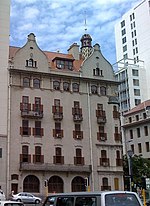Western Cape Division
1828 establishments in the Cape ColonyCape TownCourts and tribunals established in 1828Government of the Western CapeHigh Court of South Africa

The Western Cape Division of the High Court of South Africa (previously named the Cape Provincial Division and the Western Cape High Court, and commonly known as the Cape High Court) is a superior court of law with general jurisdiction over the Western Cape province of South Africa (except for the Murraysburg district which falls within the jurisdiction of the Eastern Cape Division). The division, which sits at Cape Town, consists of 31 judges led by Judge President John Hlophe.
Excerpt from the Wikipedia article Western Cape Division (License: CC BY-SA 3.0, Authors, Images).Western Cape Division
Keerom Street, Cape Town Cape Town Ward 115
Geographical coordinates (GPS) Address External links Nearby Places Show on map
Geographical coordinates (GPS)
| Latitude | Longitude |
|---|---|
| N -33.925 ° | E 18.417777777778 ° |
Address
Western Cape Division of the High Court
Keerom Street
8001 Cape Town, Cape Town Ward 115
Western Cape, South Africa
Open on Google Maps









